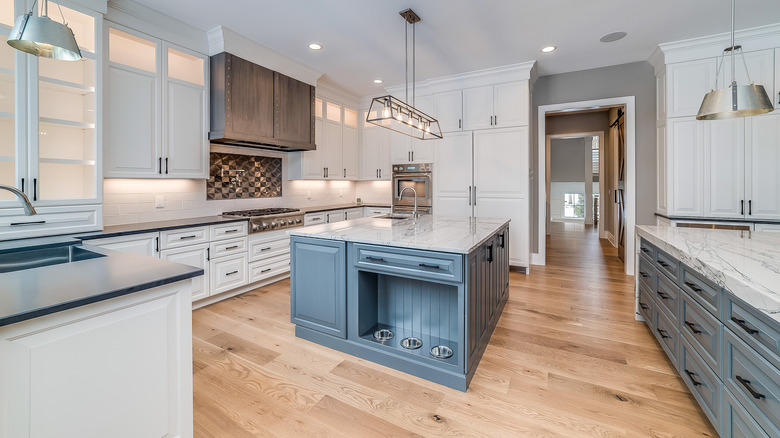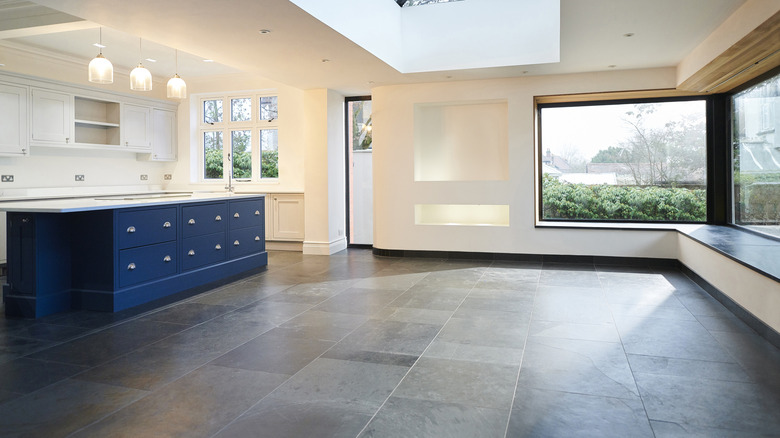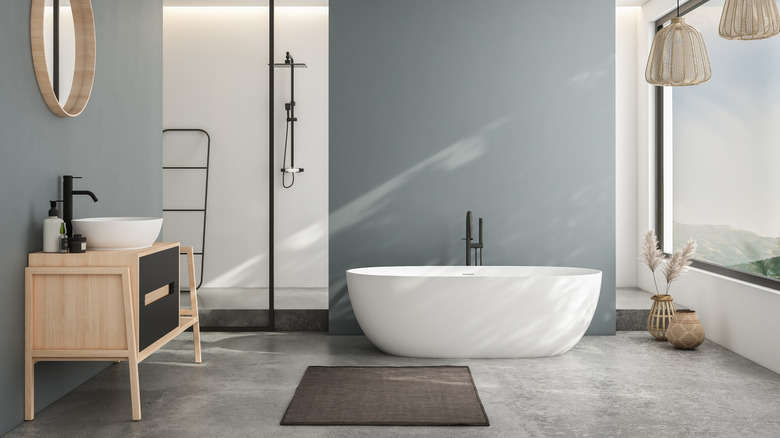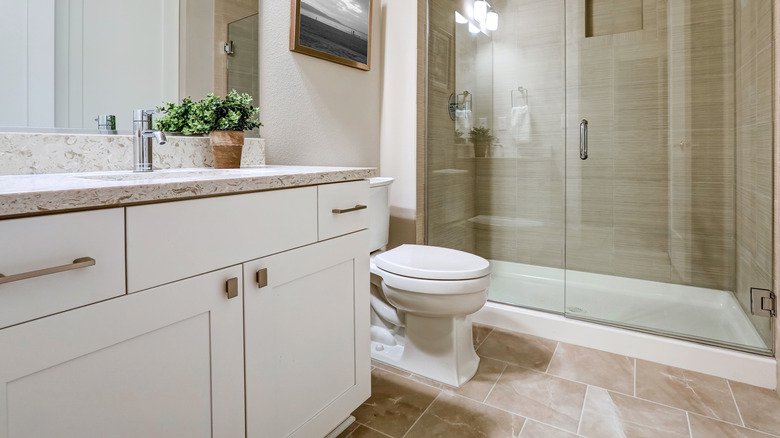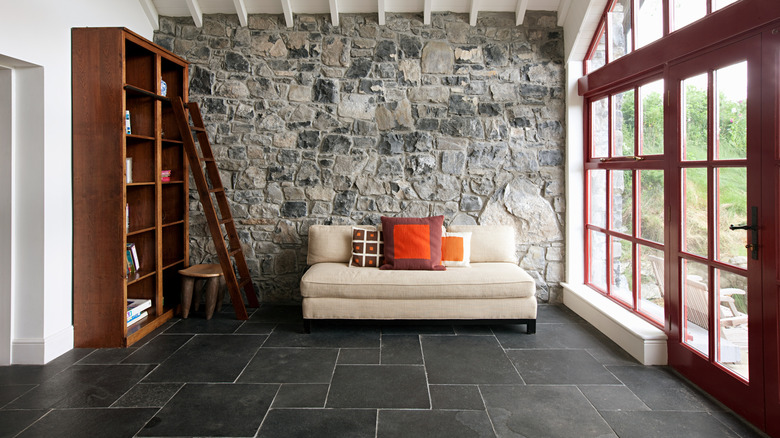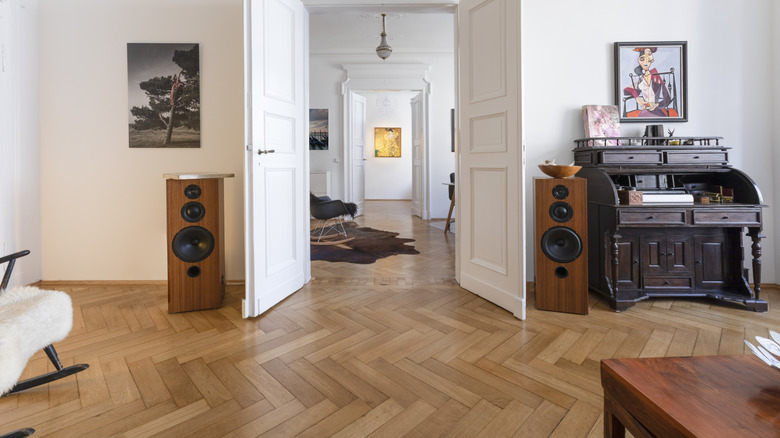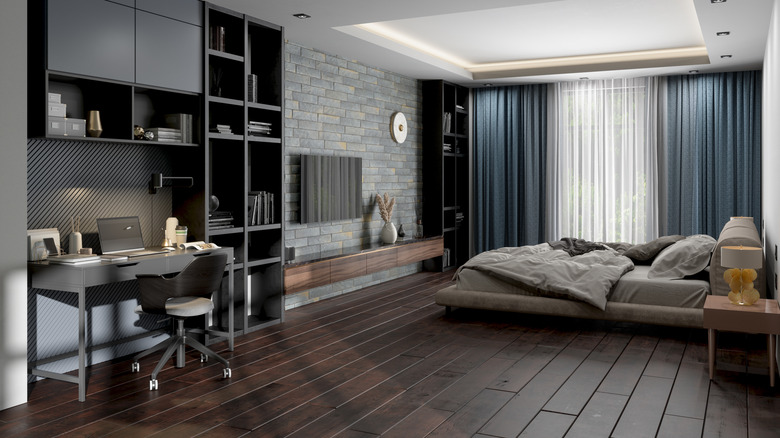The 8 Best Modern Alternatives To Dated Gray Floors
We may receive a commission on purchases made from links.
The late 2010s and early 2020s saw the rise of gray everything in interior design — gray walls, gray furniture, and most commonly, gray floors. Touted as the next great neutral color, the hue took off and quickly took over, no matter the material. Tiles, carpets, and even LVP, it all came in gray. Yet as it is with all flooring trends that take over temporarily, its reign is now coming to an end. "Gray floors are giving way for warmer, more inviting colors. Pantone's Color of the Year, Mocha Mousse is a perfect example of this," Nikki James, design studio manager at Ashton Woods Homes, exclusively tells House Digest. "This resurgence of warm browns isn't a return to the dated 'old world brown.' Instead, we're seeing a refined evolution: soft taupes, sandy beiges, and light caramels that add depth without being overwhelming."
In this House Digest exclusive, we talked to experts in the design field to find out why gray flooring has already had its heyday — and what to do next. Do you want to recreate the minimalist look that gray injected into a space, or are you looking to warm up a room because the shade always felt a little too chilly? Luckily, our experts have tips on exactly what to do to make the switch.
Warm-toned light wood helps rooms come to life
One of the main criticisms of gray as a flooring option is that it is too lifeless and boring. So it makes sense that designers who are ready to leave the trend in the past are swinging things 180 degrees to brighter, warmer tones and materials. "One alternative I've been steering my clients toward instead of dated gray floors is warm, natural wood with distinct character," Nick Smith, an expert in vintage and antique furniture and founder of Smithers, tells House Digest in an exclusive. "But here's the key — it's not just about choosing a generic 'warm wood.' The most beautiful, modern options have a refined, organic quality, like European white oak with subtle, natural variation, or lightly fumed planks that bring out depth in the grain." He says his clients love these options because they look different throughout the day, depending on the available natural light, which really adds life to each room.
No matter what shade of warmer wood you select, the next big choice is the width of the plank itself. Modern trends are leaning wider. But before you hop on the movement, here's how to tell if wide plank flooring is ideal for your home. Ultra-wide planks (think 10 inches and above) are best suited for larger spaces, like open floor plans. If you have them in a smaller room, planks this size might totally take over the space. So, if you're working with a more closed-off floor plan, or a smaller home in general, consider mid-range widths (generally around 5 inches) for your project.
Stone-look tiles are more organic and elevated
If you still have your heart set on grey flooring, adding more than one hue to the mix can make the room seem less flat. "If you really like the look of gray tiles but you want something more different and elevated, stone-look tiles are a really good example," Courtney Cole, interior designer at TileCloud, exclusively tells House Digest. "You can go for a limestone, travertine, or even warm greige. This will be great if you're looking for something more versatile and organic, but more elevated than a classic gray." The look of these more natural-feeling tile options also varies from square to square, giving the room a unique look that's more visually interesting than plain tiles.
Nick Smith also reveals you don't have to shell out the big bucks for authentic stone, either. Most manufacturers have the ability to create tiling that looks just like the real thing, for less. "The difference is in the detail — modern technology has allowed for incredibly realistic textures, so rather than looking like a printed pattern, these tiles have a depth that mimics the complexity of real stone. There's something undeniably luxurious about a continuous, uninterrupted surface of oversized tiles, and when paired with minimal grout lines, it creates a seamless, European-inspired aesthetic that feels both high-end and easy to live with," he explains. The typical tiling job has a 3/16 inch grout joint size. For this minimal look, consider 1/8 inch, but no smaller to avoid problems.
Microcement is perfect for minimalists
Many gray-floor-loving designers and homeowners initially followed the color trend because they loved the minimalist vibe it gave spaces. For example, lots of people are drawn to the style Japandi, which blends Japanese simplicity with Scandinavian practicality. It focuses on clean design, natural materials, and soft colors. Think the functionality of IKEA meets the serenity of a Japanese onsen. If your space has this feel, or you want to use the Japandi style into your home, our experts suggest a unique flooring material that still follows these guidelines without being sterile or boring. "Another really great option is to go for microcement! This will have the same streamlined look but will feel more warm," Cole says. "Not only this, but it will give you a super smooth surface that feels modern without feeling cold or harsh. This will be great if you really like the Japandi aesthetic."
Although cement is right there in the name, microcement is actually quite different in composition than traditional options. Microcement is applied in thin layers (about two or three millimeters, tops) and made from a mix of cement, polymers, and other materials which renders it sticky and flexible. It can be applied on top of existing surfaces like tiles (provided they're properly prepped), minimizing dust and disruption, while the thin additional layer won't make the overall floor profile too much higher. It also comes in different colors and textures so you can customize the look to your space. The only downside is it can be a touch expensive, at around $14-$15 per square foot, depending on the size of your project. If you're thinking of installing it yourself, here's how to DIY microcement over existing tile for a budget-friendly upgrade.
Taupes are still cool in color, but with enough warmth in their undertones
If you still want a calmer color palette, our experts have the perfect happy medium. "For those who still love cooler tones but want to avoid the datedness of mid-2010s gray, I always introduce them to desaturated taupe," says Smith. "The magic of taupe is that it's never just one thing — it has undertones of warmth but can lean cool depending on the light, making it far more dynamic than flat gray." If you are feeling unsure, Smith insists this is a very normal first reaction. Taupe interacts beautifully with natural light, so it looks slightly different based on the amount available in the space, plus the time of day you see it. For this reason, he shares that taupe "brings far more depth and interest" to any room than gray ever could. This typically convinces most.
The other thing about taupe flooring is that it works well with all colors in other parts of the room, too. You can stay neutral and have cream walls and shades of brown for your furniture, or go with a more maximalist approach with bright furniture and some bold accent walls to liven up your home. Smith also says that whether you choose taupe tiling, LVP, or even stained wood, it can play perfectly with "a moody, dramatic interior or a light and airy aesthetic," depending on the other elements in your design. This makes the color a flexible starting place to build a room from the ground up.
Honed natural stone offers timeless elegance
Unlike polished stone, which has a high-gloss sheen, honed stone is ground to a smooth, velvety surface with little to no reflection. This finish enhances the stone's natural color variations and textures while giving it a more contemporary, relaxed feel. And it's the perfect option for those trying to get away from gray. "I'm seeing a strong trend towards honed finishes, which give the stone a softer, more matte appearance. Think limestone or travertine with a subtle, velvety texture," says Smith.
This option can also extend the life of your flooring beyond a passing trend, as natural materials tend to be more timeless. Plus, "no two tiles are exactly alike, adding a unique, organic feel," Smith adds. "They are a real investment, but one that will stand the test of time, both in terms of style and durability." The price can vary widely, depending on the type of stone you select. For options like limestone, you're looking at anywhere from $13 to $17 per square foot, while basic travertine is around $3 to $8 per square foot at major retailers. You must then also factor in labor costs for installation — or save money by DIYing the project. However, laying stone correctly can be difficult without prior training.
Zellige mosaics are unique and rebel against expectation
A mosaic created from zellige tile is an intricate geometric look that will add great personality to your floors. Featuring an organic texture, their handcrafted, curated feel creates the opposite look of sterile, uniform gray planks. "Many zellige mosaics come with a mesh backing, making it easier than ever to achieve that perfectly imperfect, organic look without individually placing each tile," Camilla Masi, interior designer at Otto Tiles & Design, exclusively tells House Digest. "These authentic Moroccan tiles are staple for interior designers offering a modern rustic aesthetic." The mesh backing can also make it easier for DIYers to complete the project themselves, as they don't have to worry about such a finicky installation project.
Instead of having the cheap, mass-produced feel of all-over gray flooring, zellige mosaics give off warm and soulful vibes. As far as which tiles to choose, "My personal favorite are Terracotta Octagon Zellige tiles with White Zellige Cabochons," Masi says. "What I love about these tiles is their versatility, working in many interior styles and rooms, but if you have a more traditional or farmhouse style of home then these tiles can also look fantastic in a living space." When designing floors with zellige, don't be afraid to combine colors. Opting for a two-tone layout like the octagon tiles pictured above not only injects dimension, but it also allows you to pull in more than one shade from your color palette. Alternatively, if you prefer a monochromatic look, but still want nuance, doing your floor in something like these Authentic Handmade Aqua Zellige Tile by Squarefeet Depot, could also be an option. Even if you don't want to run zellige tile through your whole house, selections like these could be perfect for adding character to entranceways, bathrooms, or even sunrooms.
Herringbone flooring adds a touch of movement
Whether you choose warm-toned wood or stone-look tile to replace gray floors, the installation technique is just as essential to modern success as the color. Martha Chatham Wakelin, creative director at LX Hausys America, shares exclusively with House Digest that herringbone flooring is making the biggest of comebacks. "Another modern approach is herringbone installations, which add movement and visual interest," she says. "This classic pattern is seeing a resurgence, bringing a refined, Art Deco-inspired elegance to floors while maintaining a timeless aesthetic."
The great thing about herringbone is that it works well with a variety of flooring types to add personality to a space. Some of the best materials for herringbone floors include tiles, wooden or LVP planks, or even bricks — which are arranged in a V-shaped, zigzag formation. Fun fact: Yes, it gets its name because it looks like the skeleton of a herring fish. Made popular from the 1920s in the Art Deco movement, the style has never lost its footing as it consistently made appearances throughout the 1950s and well into the modern era. No matter what material you select, choosing a herringbone installation is a great way for your flooring choice to outlast passing trends. Herringbone floors can be costlier to install, because perfectly laying the individual planks, tiles, or bricks in this pattern is intricate work and takes more time. But, you might be able to save on this added expense (or hassle, if you choose to DIY) by opting for smaller-scale herringbone tiles that come on a mesh backing, such as this Stone Center Online Carrara White Marble Herringbone Mosaic Tile.
Mid-to-deep wood tones add drama and contrast
Hardwood floors are always a classic, but only when they are in their original color, or stained another shade of brown. If you have gray floors (even if they are LVP that are meant to mimic wood), they're rapidly becoming dated. As for the best shades of wood tone, our experts weigh in. "A warm walnut or classic oak adds character and sophistication without feeling overly traditional. It pairs beautifully with both modern and vintage elements, making it a versatile choice that won't feel outdated anytime soon," Elizabeth Vergara, founder and principal of Vergara Homes, exclusively tells House Digest.
Yet for some, these floors feel too light and airy and they prefer a darker tone. "For a bolder, more contemporary look, dark espresso or nearly black floors make a statement," Vergara continues. To make these dark floors work, however, she is quick to advise readers that lighter walls and softer textures around the rest of the room are a must. This way, she says, along with lots of natural light, the space doesn't feel too heavy. Another way to balance out the intensity of rich wood floors is by adding light-toned rugs. For instance, something like this Soalmost Washable Area Rug could help to brighten and ground a living room seating area. Alternatively, if you want some subtle color in the space, the warm shades in these Zesthome Area Rugs could pair perfectly with an expresso-toned hardwood floor.

